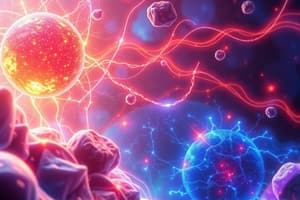Podcast
Questions and Answers
What is the preferred source of energy for the body according to the text?
What is the preferred source of energy for the body according to the text?
- Proteins
- Carbohydrates (correct)
- Fats
- Minerals
Which type of organisms are able to make energy-containing organic molecules from inorganic raw material?
Which type of organisms are able to make energy-containing organic molecules from inorganic raw material?
- Autotrophs (correct)
- Herbivores
- Carnivores
- Heterotrophs
What are heterotrophs unable to do based on the text?
What are heterotrophs unable to do based on the text?
- Produce own food (correct)
- Use sunlight as an energy source
- Convert inorganic compounds into glucose
- Consume organic compounds
What is the role of ATP in biologic systems according to the text?
What is the role of ATP in biologic systems according to the text?
Which category of metabolism involves the synthesis of all compounds needed by the cells?
Which category of metabolism involves the synthesis of all compounds needed by the cells?
What is the main purpose of Catabolism in metabolism?
What is the main purpose of Catabolism in metabolism?
Which process involves the intracellular conversion of nutritive material into cellular components?
Which process involves the intracellular conversion of nutritive material into cellular components?
What is the primary role of Bioenergetics in living systems?
What is the primary role of Bioenergetics in living systems?
What is the primary function of Adenosine Triphosphate (ATP) in cells?
What is the primary function of Adenosine Triphosphate (ATP) in cells?
Which molecule serves as the main energy source for cellular processes in mitochondria?
Which molecule serves as the main energy source for cellular processes in mitochondria?
What is the empirical formula for carbohydrates like glucose?
What is the empirical formula for carbohydrates like glucose?
How are monosaccharides connected to form larger carbohydrate structures?
How are monosaccharides connected to form larger carbohydrate structures?
What is one of the earliest tests for the presence of sugar in urine of diabetics?
What is one of the earliest tests for the presence of sugar in urine of diabetics?
Which enzyme is responsible for the digestion of major dietary polysaccharides in the mouth?
Which enzyme is responsible for the digestion of major dietary polysaccharides in the mouth?
How are glucose and galactose absorbed in the small intestine?
How are glucose and galactose absorbed in the small intestine?
What is the preferred nutrient for energy generation mentioned in the text?
What is the preferred nutrient for energy generation mentioned in the text?
Which process is responsible for forming a disaccharide from two monosaccharides?
Which process is responsible for forming a disaccharide from two monosaccharides?
Which of the following sugars is classified as a reducing sugar?
Which of the following sugars is classified as a reducing sugar?
What type of sugar does not have an aldehyde or ketone group and cannot act as a reducing agent?
What type of sugar does not have an aldehyde or ketone group and cannot act as a reducing agent?
Which enzyme is essential for breaking down lactose into glucose and galactose?
Which enzyme is essential for breaking down lactose into glucose and galactose?
Flashcards are hidden until you start studying
Study Notes
Energy Sources and Metabolism
- Glucose is the preferred source of energy for the body.
- Autotrophs are organisms that can make energy-containing organic molecules from inorganic raw materials.
- Heterotrophs are unable to make energy-containing organic molecules from inorganic raw materials.
ATP and Bioenergetics
- ATP (Adenosine Triphosphate) plays a crucial role in biologic systems as the energy currency.
- The primary role of Bioenergetics is to study the flow of energy through living systems.
- ATP is the primary energy source for cellular processes in mitochondria.
Carbohydrate Structure and Digestion
- The empirical formula for carbohydrates like glucose is C6H12O6.
- Monosaccharides are connected to form larger carbohydrate structures through glycosidic bonds.
- Amylase is the enzyme responsible for the digestion of major dietary polysaccharides in the mouth.
- Glucose and galactose are absorbed in the small intestine through facilitated diffusion.
Sugar Chemistry
- Sucrose is formed through a condensation reaction, responsible for forming a disaccharide from two monosaccharides.
- Reducing sugars, such as glucose and galactose, have an aldehyde or ketone group and can act as a reducing agent.
- Non-reducing sugars, such as sucrose, do not have an aldehyde or ketone group and cannot act as a reducing agent.
- Lactase is the enzyme essential for breaking down lactose into glucose and galactose.
Glucose and Energy Generation
- Glucose is the preferred nutrient for energy generation.
Studying That Suits You
Use AI to generate personalized quizzes and flashcards to suit your learning preferences.




